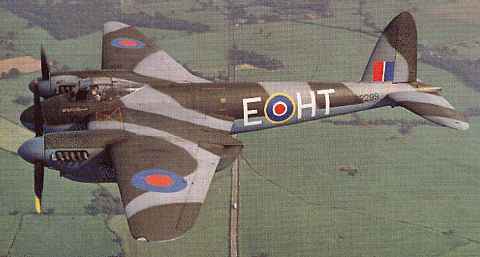

The "Mossie" was simple in construction and design. It was a twin engine, single boom aircraft with the pilot and navigator sitting side-by-side. It was one of the most cost effective aircraft ever built. Included in the construction was Ecuador balsa for the plywood skin, Sitka spruce from Alaska and B.C. in the wing spar, Douglas Fir stringers and birch and ash for the longitudinal members. These were all held together with glue and wood screws. The result was an airplane that was easy to maintain, tolerant of battle damage and simple to patch. It was faster than the Spitfire, flew higher than almost any other aircraft and carried tremendous fire power and a bomb load over tremendous distances. The bomber version operated with relative impunity over Germany to the end of the war, because the Luftwaffe never had a nightfighter fast enough to intercept it. The nightfighter versions remained in production until 1947.
It was originally designed as an unarmed bomber, when the experts in the military were against the idea. It almost resulted in cancellation of the project. Geoffrey de Havilland persevered and proved the abilities of the Mosquito in many roles. It had the lowest loss rate as a % of sorties of any aircraft in Bomber Command. It also excelled as a day and night fighter, intruder, fighter-bomber, photo-reconnaissance, dual-control trainer, airliner and transport aircraft for the Dutch and French resistance.
Technical Details
The Mosquito Nighter Fighter Mk II was powered by two 1075 kW Rolls-Royce XXIII engines that gave it a maximum speed of 365 mph and a range of 1671 miles. It’s armament was the standard (for the Mossie) four 0.303 machine guns in the nose and four 20 mm cannons under the nose in the forward bomb-bay. It first flew in 1942.
The Mosquito Mk VI was powered by two Rolls-Royce Merlin engines, first the 1250 hp Merlin XXI and then the 1650 hp Merlin XXV. It’s maximum speed was 380 mph at 13,000 feet fully loaded. It could do over 400 easily without bombs. It’s range was 1205 miles, 1705 with extra fuel tanks. The Mk VI fighter/bomber was the most numerous version made. The Mosquito was the fastest operational aircraft of the 2nd World War until mid-1944. The Mk VI was armed with the standard 4+4 in the nose, with an additional bomb load of 2 250 lb bombs in the rear of the bomb-bay and two more on pylons on the wings, in-board of the engines. It first flew in 1943.
The upgraded Night Fighter Mk XXX was powered by the 1710 hp Rolls-Royce Merlin 76 engines giving it a maximum speed of 416 mph and a range of 1159 miles. It had the standard 4+4 armament in the nose. It first flew in 1944.
 Canadian Aces Home Page
Canadian Aces Home Page
Image from: An aircraft image archive.